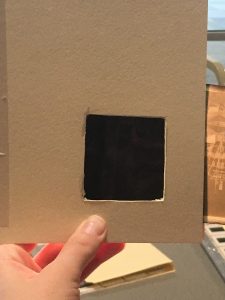We’re a teensy bit late on May Day this year. On May 1, we often celebrate May Day by doing something to help us out with preservation or disaster recovery planning. We’ve been getting some collections with old stills in recently so we decided it was time to figure out how to tell if something is cellulose based stock or not. Both acetate and nitrate cellulose film stock are best stored frozen. (Here’s an earlier blog entry about nitrate moving image stock gone wrong.)
I’ll skip the history of film stock and nitrate in particular since you can find that easily enough elsewhere (here’s one source) and I’ll skip the long version of why we’re keeping the stuff when we can. But it’s not always simple to tell what the film stock is. Some have little notches in the edges of the negative where different patterns can tell you what type it is, but not all do. And unfortunately most of the definitive tests that determine whether something is nitrate specifically are either illegal for us to do (burning) or impractical (chemical testing with some seriously nasty chemicals). They’re all basically destructive, which means you’d have to clip a section off the negative to test it. The problem with that is that not all negatives have clear space on the edges allowing for clipping without cutting into the image, even if we could do chemical or burn testing.
Since Veronica and Arlene both were working with collections of the appropriate age to have nitrate or acetate cellulose stock and both of which had a lot of still negatives in them, unfortunately without the notch coding, it was time to see if we could figure something out. According to one of our colleagues in AMIPA, who is our resident expert in all things film-related, there’s a polarization effect that happens with polyester based films that doesn’t happen with cellulose based films. So we found some instructions from the National Park Service on how to build a quick and easy film viewer with a polarizing filter that would allow us to do some quick checks. So that’s what we did today to celebrate Archives May Day.
- the supplies lined up
- cutting the mat board to size
- marking the aperture holes
We gathered our supplies and started cutting the mat board to size, the filtering film to size, and taping the pieces together. They’re not the prettiest things on earth, mat stock does not yield easily to a cutting blade, plus the craftiest of our bunch is Arlene and she failed scissors in kindergarten, but the end result mostly looked like what was in the NPS instructions.
And that’s when things went a bit awry. First of all it took us all a while to get the polarizing film oriented correctly. And then we were having problems seeing the interference patterns on our sample of polyester based film. But with a little help with from our AMIPA expert and carefully holding it up against one of our new, very bright task lamps, we finally saw the difference between the two. And we also decided that we need to keep a piece of polyester film on the side so we remember what it looks like since what we’re looking for is the absence of that look in the cellulose stock. We also learned that we should not look directly into our new, very bright task lamps since they’re, well, very bright.
- Nitrate stock
- Polyester stock–the arch to the left is the lamp, the arch in the middle on the right is the film stock)
- Our polarizer
That’s what we did for May Day. And we have an offer for you: we built three of these but we don’t need three. So we’re offering one of the ones we built (the prettiest one of the bunch) to the first archives, library, or museum in Alaska who contacts us and asks for it. Please use the contact link above and include your mailing address and institution name and we’ll get it mailed out to you.
Happy May Day!








